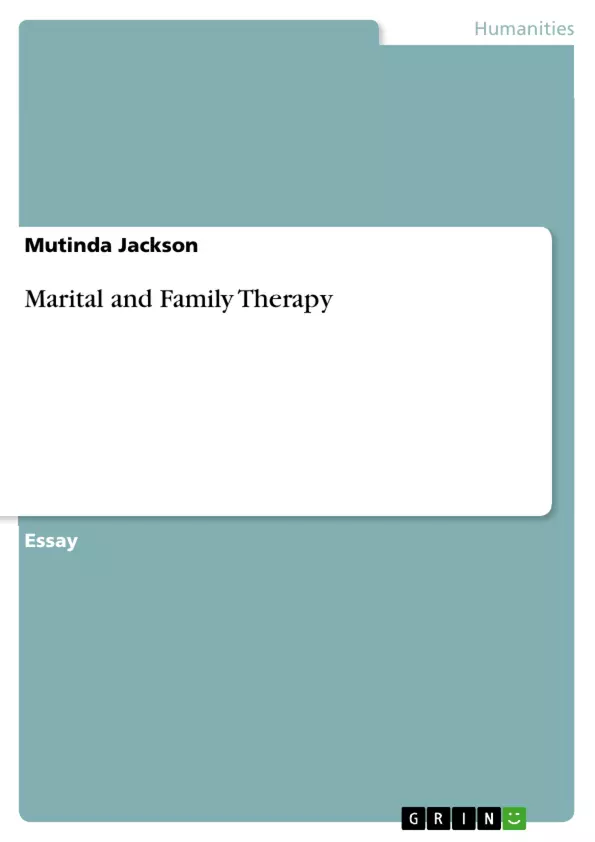Accordingly, the patterns of behavior of families have been observed to influence the individual, thus, may need to be a part of the treatment. In both marriage and family therapy, research has it that the unit of treatment is not only the individual, even if the interview is on a single person, but also remains to be the set of relationships imbedding the person. In short, marriage and family therapy refers to a brief solution-focused specific that contain attainable therapeutic goals, designed with the so termed the ‘end in mind’. Family and marriage therapists have the ability of treating a number of serious clinical problems.
The goal of family therapy is to bring change not only in an individual, but also in the structure of the family and the sequences of behavior among its members. As it will be noted, this paper analyses the major differences between individual therapy and couples therapy, discuss how treatment goals are decided and addressed for these two therapies, the ethical implications evident along with identifying the patient/or client for a marital and family counselor.
Inhaltsverzeichnis (Table of Contents)
- Introduction
- Differences between Individual and Couples/Family Therapy
- Deciding and Addressing Treatment Goals for Individual & Couples Therapies
- Ethical Implications of Individual and Couples Therapists Collaboration
- Identifying Who the Client Is For a Marital and Family Counsellor
- Conclusion
Zielsetzung und Themenschwerpunkte (Objectives and Key Themes)
This paper provides an insightful analysis of the differences between individual therapy and couples/family therapy. It explores the process of establishing and achieving treatment goals in both contexts, highlighting the ethical considerations involved in collaborative work. The paper concludes by examining the unique characteristics of marital and family counseling, emphasizing the multifaceted nature of the "client" in this setting.
- Differences between Individual and Couples/Family Therapy
- Treatment Goal Setting and Implementation in Individual and Couples Therapy
- Ethical Challenges in Collaborative Work between Individual and Couples Therapists
- Identifying the Client in Marital and Family Counseling
- The Importance of Communication and Behavior Modification in Couples Therapy
Zusammenfassung der Kapitel (Chapter Summaries)
- Introduction: This chapter sets the stage by defining the concept of marriage and family therapy, emphasizing its focus on the individual and their relationships within the family unit. It highlights the goal of bringing change not only to individuals but also to the family structure and interaction patterns.
- Differences between Individual and Couples/Family Therapy: This chapter delves into the core distinctions between individual therapy, which centers on one-on-one interaction with the therapist, and couples therapy, which focuses on enhancing communication and interaction within the couple's relationship. It emphasizes the importance of therapeutic goals and the need for therapists to understand diverse theoretical orientations in providing effective treatment.
- Deciding and Addressing Treatment Goals for Individual & Couples Therapies: This chapter explores the principles of effective therapy, highlighting the critical role of therapist expertise in tailoring treatment plans. It emphasizes the significance of evidence-based approaches and the importance of addressing the unique needs and challenges of both individual and couples therapy clients. It discusses various principles, including changing perspectives, modifying dysfunctional behavior, decreasing emotional avoidance, and promoting effective communication skills.
- Ethical Implications of Individual and Couples Therapists Collaboration: This chapter focuses on the ethical challenges faced by therapists who work with both individuals and couples, highlighting the need for careful consideration of confidentiality and the complexities of collaboration. It discusses the potential ethical conflicts arising from dual roles and recommends referral to another therapist when appropriate.
- Identifying Who the Client Is For a Marital and Family Counsellor: This chapter examines the unique characteristics of marital and family counseling, emphasizing that the "client" is not simply an individual but a complex interplay of relationships within the family unit. It highlights the need for therapists to understand the family dynamics and the importance of facilitating open communication among family members.
Schlüsselwörter (Keywords)
This paper delves into the key concepts of marital and family therapy, exploring the distinctions between individual and couples/family therapies. It examines the importance of treatment goals, effective therapeutic interventions, and the ethical considerations surrounding collaborative work between individual and couples therapists. Additionally, the paper highlights the unique nature of the client in marital and family counseling, emphasizing the complexities of family dynamics and the significance of communication within the family unit.
- Arbeit zitieren
- Business Administrator Mutinda Jackson (Autor:in), 2018, Marital and Family Therapy, München, GRIN Verlag, https://www.grin.com/document/429514



